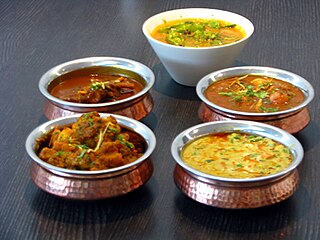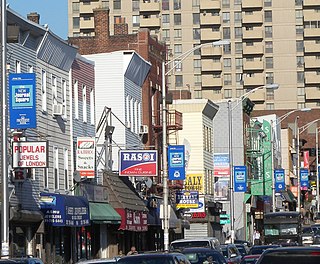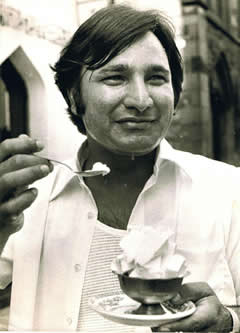Related Research Articles

Curry is a dish with a sauce seasoned with spices, mainly associated with South Asian cuisine. It is not to be confused with leaves from the curry tree, though some curries do include curry leaves. Curry is also found in the native cuisines of many South East Asian and East Asian countries due to ancient contact with South Asia.

Chicken tikka masala is a dish consisting of roasted marinated chicken chunks in a spiced sauce. The sauce is usually creamy and orange-coloured. The dish was popularised by cooks from India living in Great Britain and is offered at restaurants around the world.

Little India is an Indian or South Asian sociocultural environment outside India or the Indian subcontinent. It especially refers to an area with Indian residences and a diverse collection of Indian businesses. Frequently, Little Indias have Hindu temples, mosques, and gurdwaras. They may also host celebrations of national and religious festivals and serve as gathering places for South Asians. As such, they are microcosms of India. Little Indias are often tourist attractions and are frequented by fans of Indian cuisine, Indian culture, Indian clothing, Indian music, and Indian cinema.

The Curry Mile is a nickname for the part of Wilmslow Road running through the centre of Rusholme in south Manchester, England. The name is earned from the large number of restaurants, takeaways and kebab houses specialising in the cuisines of South Asia and the Middle East, thought to be the largest concentration of South Asian restaurants in the United Kingdom. The Curry Mile is notable for its streets being busy into the early hours of the morning. The area is frequently visited by local students, because of its location near the Oxford Road and Fallowfield Campuses of the University of Manchester, Xaverian College and the Oxford Road/All Saints campus of the Manchester Metropolitan University.

Sant Singh Chatwal is an Indian American businessman and founder of the Dream Hotel Group where he is chair of the board. He has founded numerous hotel brands including The Chatwal, Dream Hotels, Time Hotels, and Unscripted Hotels, which operate in the United States and internationally.

Bangladeshi Americans are Americans of Bangladeshi descent. Most Bangladeshi Americans are also Bengali Americans. Bangladeshi Americans are usually Muslims with roots in Bangladesh in which Bengali is the majority language. Since the early 1970s, Bangladeshi immigrants have arrived in significant numbers to become one of the fastest growing ethnic groups in the U.S. New York City is home to two-thirds of the Bangladeshi American population. Meanwhile, Paterson, New Jersey and Atlantic City, New Jersey are also home to notable Bangladeshi communities. Over 400,000 people leave Bangladesh with the sole goal of finding employment in other countries.

Bangladeshi cuisine has been shaped by the region's history and river-line geography. Bangladesh has a tropical monsoon climate. The staple of Bangladesh is rice and fish. The majority of Bangladeshi people are ethnic Bengali, accustomed to Bengali cuisine, with a minority of non-Bengalis, many used to cuisines from different traditions and regions. Bangladeshi cooking features more meat dishes than the cuisine of neighbouring West Bengal, India.

Indian Chinese cuisine, Chinese Indian cuisine, Sino-Indian cuisine, Chindian cuisine, Hakka Chinese or Desi-Chinese cuisine is a distinct style of Chinese cuisine adapted to Indian tastes, combining Chinese foods with Indian flavours and spices. Though Asian cuisines have mixed throughout history throughout Asia, the most popular origin story of the fusion food resides with Chinese labourers of Calcutta, who immigrated to British Raj India looking for work. Opening restaurant businesses in the area, these early Chinese food sellers adapted their culinary styles to suit Indian tastes.
The history of Indian cuisine consists of cuisine of the Indian subcontinent, which is rich and diverse. The diverse climate in the region, ranging from deep tropical to alpine, has also helped considerably broaden the set of ingredients readily available to the many schools of cookery in India. In many cases, food has become a marker of religious and social identity, with varying taboos and preferences which has also driven these groups to innovate extensively with the food sources that are deemed acceptable.
The Curry Club was founded by Pat Chapman in 1982, to further the understanding and appreciation of the cuisines of the Indian subcontinent. In 2007 it became known as Pat Chapman's Curry Club.

Enam Ali was a Bangladeshi-born British businessman who founded The British Curry Awards, Spice Business Magazine, and Ion TV.

Indians in the New York City metropolitan area constitute one of the largest and fastest-growing ethnicities in the New York City metropolitan area of the United States. The New York City region is home to the largest and most prominent Indian American population among metropolitan areas by a significant margin, enumerating 711,174 uniracial individuals based on the 2013–2017 U.S. Census American Community Survey estimates. The Asian Indian population also represents the second-largest metropolitan Asian national diaspora both outside of Asia and within the New York City metropolitan area, following the also rapidly growing and hemisphere-leading population of the estimated 893,697 uniracial Chinese in the New York City metropolitan area in 2017.

Kalustyan’s is a shop located at 123 Lexington Avenue, Manhattan, New York City, that originally sold primarily Middle Eastern spices and foods and, increasingly, an extensive selection of culinary products from around the world. Established in 1944 by Kerope Kalustyan, an Armenian from Turkey, it sold Turkish and Middle Eastern spices, dried fruits, nuts, oils and grains, when the neighborhood was largely Armenian. In late 1960s and 1970s, when New York become home to a significant number of Indians, Kalustyan’s expanded itself to cater to the Indian market, while bringing out its own brand of chutney and mango pickles.
Oak Tree Road is a predominantly South Asian shopping, business, and dining district centered on a road designated County Route 604 in Middlesex County, in Central New Jersey. The district, which has been called "Little India," is set amidst a suburban residential area that is home to many South Asian families.
Ayub Ali Master, was an early British Bangladeshi social reformer, politician and entrepreneur. He is notable for pioneering social welfare work for many early British Asians. He established a boardinghouse known as "Number 13" in his home which provided many facilities for British Asians. He is one of the earliest of Sylhetis to arrive in the United Kingdom, now hosting one of the largest Bangladeshi diaspora communities outside of Bangladesh and due to this, he was amongst the famous household names in the Sylhet region during his time referred to as the brave jahazis (sailors). His family is also notable as entrepreneurs and businessmen.
Shah Abdul Majid Qureshi, also known by his daak naam Moina Meah, was an early British Bangladeshi restaurateur and social reformer. He is notable for being involved in the early politics of British Asians and pioneering social welfare work for the working-class diaspora in the United Kingdom. He claimed to be the first Sylheti to own a restaurant in the United Kingdom. One of his later restaurants, India Centre, often provided facilities and was a location where important meetings were held by the India League attracting the likes of Subhas Chandra Bose and V. K. Krishna Menon.

Floyd Cardoz was an Indian-American chef. He was born in Mumbai. He owned the New York City eatery Paowalla and was executive chef at Tabla, as well as victor on Top Chef Masters Season 3 in 2011. His New York restaurants were known for food melding Indian flavours and spices with western cuisine.

Curry, a spicy South Asian-derived dish, is a popular meal in the United Kingdom. Curry recipes have been printed in Britain since 1747, when Hannah Glasse gave a recipe for a chicken curry. In the 19th century, many more recipes appeared in the popular cookbooks of the time. Curries in Britain are widely described using Indian terms, such as korma for a mild sauce with almond and coconut, Madras for a hot, slightly sour sauce, and pasanda for a mild sauce with cream and coconut milk. One type of curry, chicken tikka masala, was created in India, but has become widespread enough to be described as the national dish of the United Kingdom.

Ali Ahmed Aslam was a Pakistani–Scottish chef who is credited with inventing the dish chicken tikka masala.
References
- 1 2 3 Lam, Francis (2015-04-29). "The Mysteries of Manhattan's Curry Row". The New York Times . Retrieved 2022-07-29.
- 1 2 3 4 5 6 Jacobs, Andrew (1997-01-19). "Bad Days on Sixth Street". The New York Times . Retrieved 2022-07-29.
- 1 2 Fishbane, Matthew (2008-01-13). "A Passage to India". The New York Times . Retrieved 2022-07-29.
- ↑ Feretti, Fred (1981-03-04). "A Culinary 'Little India' on East 6th Street". The New York Times . Retrieved 2022-07-29.
- ↑ Rao, Meghna (2019-07-31). "In Manhattan's Curry Row, Innovate or Die". The Juggernaut . Retrieved 2022-07-31. - Information on the publication